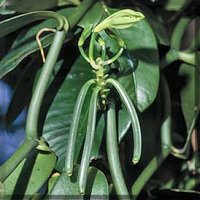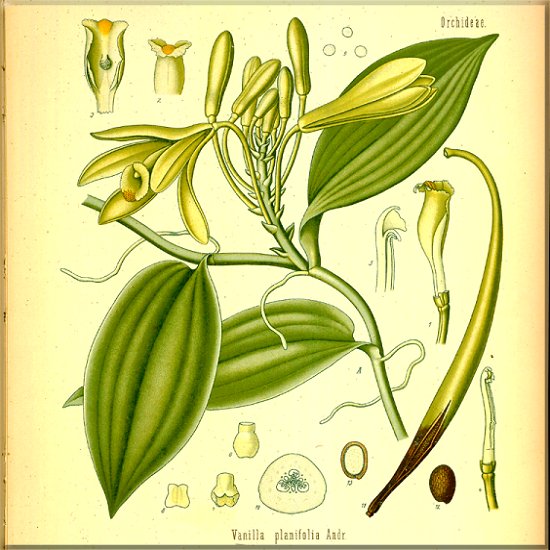



Vanilla Planifolia




Vanilla
Planifolia
Origin and Location - Madagascar, Comoros Islands, Reunion, French Polynesia, Tahiti, Indonesia, Malaysia, Mozambique, Seychelles, Uganda, Guatemala, Mexico. In the nineteenth century, Mexico was the largest vanilla producer, but since the First World War some islands in the Indian Ocean have become the world's largest centre of production. Today the largest exporters are Madagascar, Comores Islands, Reunion Island, China and Indonesia. The big consumers are the western countries: the USA, Canada, EEC countries, Japan and Australia (Ferrão, 1993).
Description - Vanilla is a Flavouring derived from orchids in the genus Vanilla. The name came from the Spanish word "vainilla", diminutive form of "vaina" (meaning "sheath"), which is in turn derived from Latin "vagina". [1]
The vanilla plant is a vine, native from the tropical forests of Central America and some areas of South America. In its natural habitat, it may reach a length of 25 meters, climbing with the help of adventitious roots. The stems are thick and fleshy green; the leaves are alternate, long elliptical, sessile and bright green. The flowers, in clusters, appear in the leaf axils. They live only 8 hours and die if fertilization fails to occur. The plant blooms three years after the cuttings are planted and the yellow greenish fruits many have up to 90,000 seeds, taking five to seven months to mature. The fruit is scentless when harvested, it has a length between 10 to 25 cm and a weight of 5 to 30g (Ferrão, 1993).
Method of Fermentation - Commercial vanilla is obtained after special processing of the fruits. First they are put in hot water and then dried to allow fermentation to occur. In Madagascar, the world's largest producer of vanilla, the fruits are sundried and wrapped in blankets at night to remain warm. This is a long process that takes months and increases the cost of the product. This spice is one of the most expensive, second only to saffronThe commercial fruit has a black/brown colour and a soft and flexible touch, due to several oxidations that take place inside it. If they are harvested before the proper time they are poor in aromatic compounds and if the harvesting is made too late, they will initiate the dehiscence process, with a great loss in market prices. After all these long lasting processes, small crystals of vanillin, the most valuable compound of the fruit, naturally cover the fruit.
Other Uses - It I used in extenively in the food industry as flavoring additive. The perfume industries also use vanilla as a basic or middle note because of its rich, sweet and balsamic scent (Williams, 1997). The major part of the world's vanilla is used for making vanilla extracts, used on a large scale in finer chocolate, ice-cream, cookies, etc.
Pharmacology - Though there are many compounds present in the extracts of vanilla, the
compound predominantly responsible for the characteristic flavor and smell of
vanilla is known as vanillin
(4-hydroxy-3-methoxybenzaldehyde), but several additional aroma compounds are formed during the curing
process (more than 100 are identified). Guaicol, creosol, acetovanillone,
vanillyl alcohol and methyl salicylate seem to be of importance, together with
vitispiranes [110] [111].
Another minor component of vanilla essential oil is piperonal (heliotropin). Piperonal
and other substances affect the odour of
natural vanilla.
Vanilla essence comes in two forms: the actual extract of the seedpods, and the far cheaper synthetic essence, basically consisting of a solution of synthetic vanillin in ethanol. Natural vanilla is an extremely complicated mixture of several hundred different compounds, versus synthetic vanillin which is derived from phenol and is of high purity.
Medicinal Uses - “Vanilla is an aromatic stimulant, with a tendency towards the nervous system. It has also been regarded as an aphrodisiac. It has been employed as a remedy in hysteria, low fevers, impotency, etc.